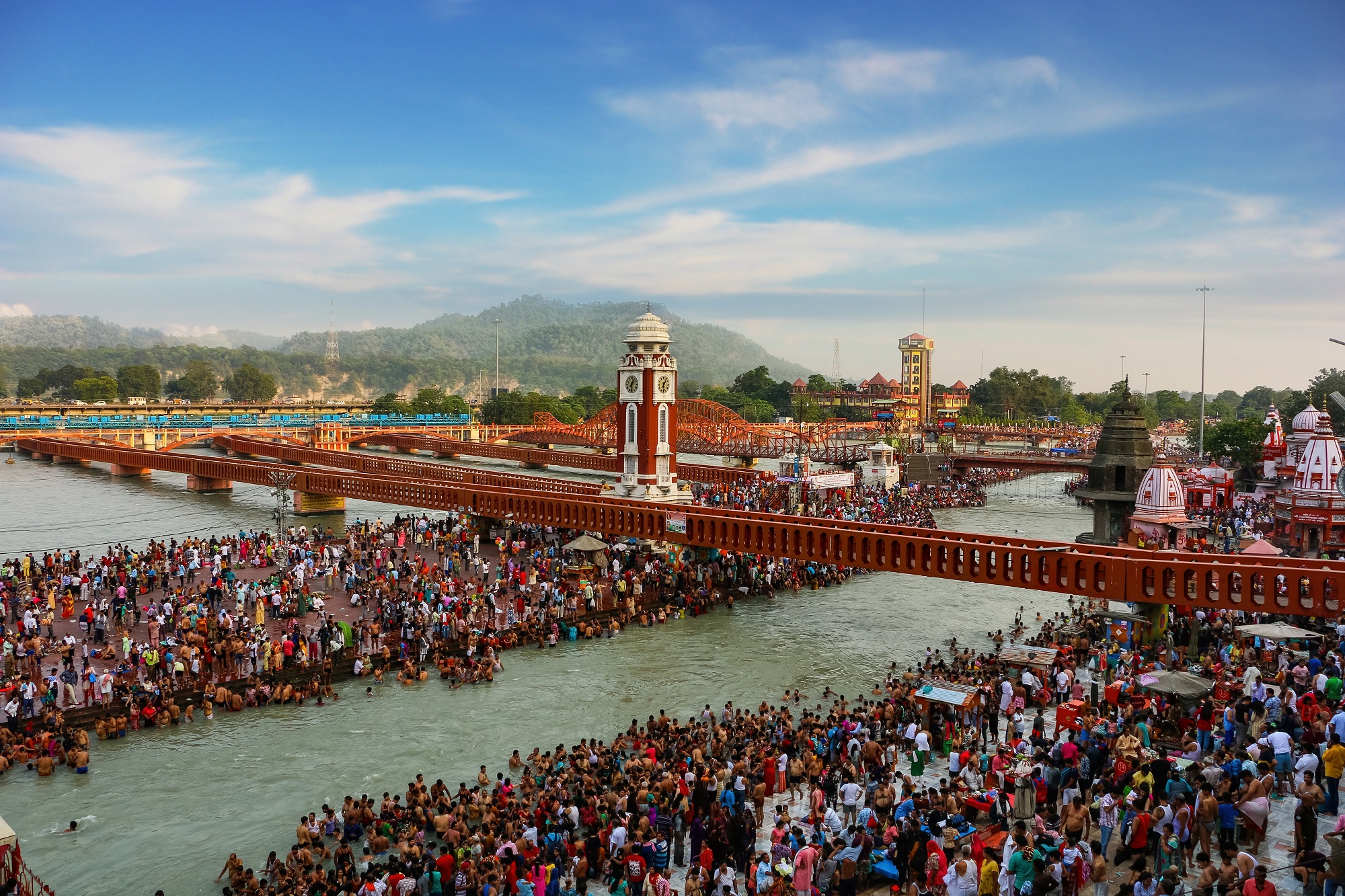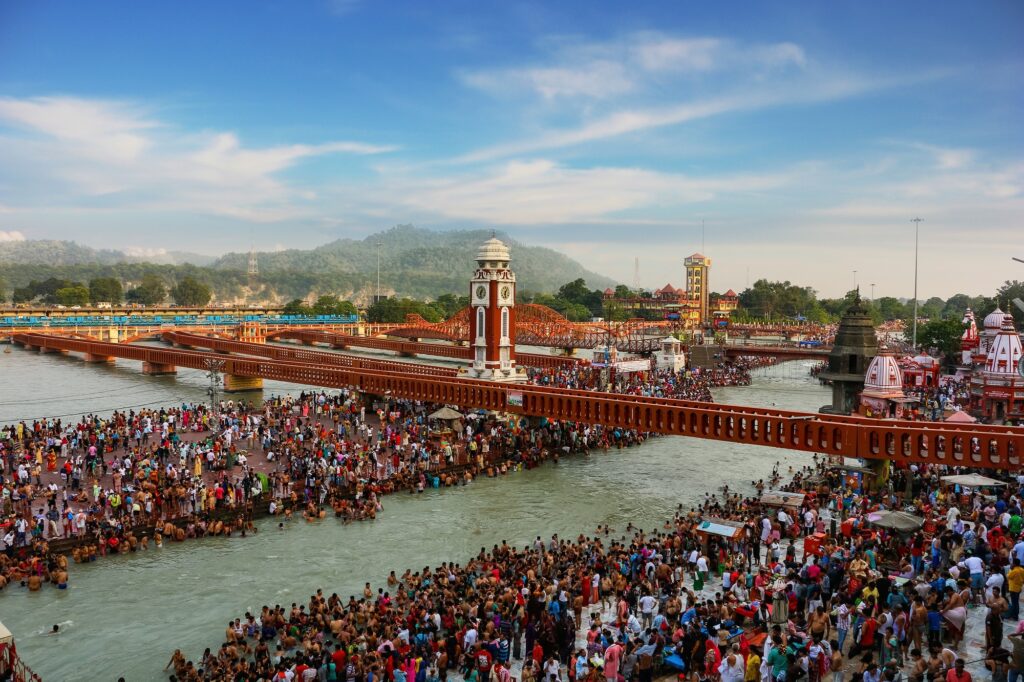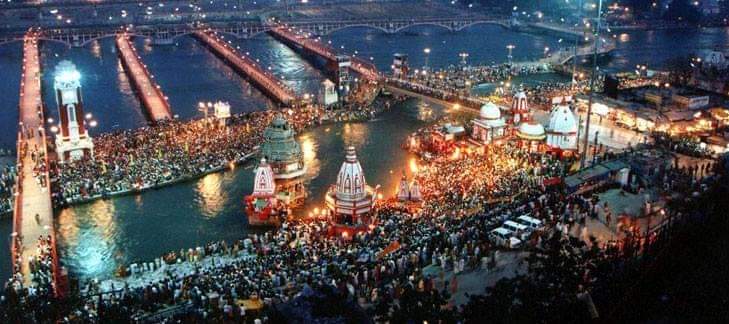
Haridwar is a name which instantly strikes a divine chord in everyone’s heart irrespective of whether they are religious or not. The name ‘Haridwar’ itself is clear i.e. The gateway to Hari. Located on the right bank of the sacred Ganga at the foothill of the Shivalik Hills, Haridwar is the second largest city in the Indian state of Uttarakhand.
Haridwar is as old as civilization and continues to contribute a lot to the advancement of civilization. It is one of the sapta-moksha puris.
The Pancha Tirtha are the five most sacred spots of Haridwar. They comprise of Gangadwara, Kushwart, Kankhal, Bilwa Parvat and Neel Parvat, all of which lie in the municipal city of Haridwar.
It is an entry point for the pilgrimage to the Chota-Char Dhams of Uttarakhand i.e. Badrinath, Kedarnath, Gangotri and Yamunotri. The mix of the luscious-green thick forests with the streams of the cooling and sacred Ganga lends an authentic spiritual character and gladdens the hearts of devotees. Also, Haridwar is visited by tourists to see its majestic temples and natural beauty.
An important event that happens in Haridwar every 12 years is the Kumbha Mela where lakhs of devotees converge to bathe in the sacred Ganga river. The Ardh-Kumbh Mela happens every six years. The last Purna-Kumbh Mela happened in 2021. You must not miss the Ganga Arati at Har Ki Pauri if you wish to explore Haridwar deeply.
The Vedic History
The sacred city is trenched deep in history. It has been part of various kingdoms such as the Mauryan Empire, Kushan Empire, etc., but its sacredness and spiritual potency has never changed. The Islamic invasions saw the destruction of many temples. But none affected the character of this city. The British came later followed by Indian independence.
But the people of Bharat Varsha were never affected by these events. They continued to go to this holy place be it for the dead or for their own/family well-being. After more and more people from India and abroad realized the importance of this sacred city in their lives, the inflow of pilgrims into the city has been increasing steadily over years.

Haridwar is one of the four holy sites where Amrita i.e. nectar of immortality fell from the pot carried by Garudadeva during the Samudra manthan (churning of the ocean). It fell at the site of the Brahma Kunda which is located at Har Ki Pauri.
Scriptures refer to Haridwar also by the names Kapilasthana, Mayapuri and Gangadwara. It was the abode of Sage Kapila and hence, came to be called Kapilasthana. It is the abode of Maya Devi and hence, the name Mayapuri or Maya.
Haridwar becomes Gangadwara too
Ganga used to flow throughout the universe going from one planetary system to the other after she started flowing out from a hole in the covering of Vaikuntha. This hole was created by Lord Vamana’s lotus toe during His lilas with Bali Maharaja. King Bhagiratha wanted to liberate his 60,000 ancestors who were burnt by the fiery of Sage Kapila. The previous kings had attempted to liberate them but weren’t successful.

King Bhagiratha was successful in his penances and hence was able to bring down the sacred Ganga with the help of Lord Shiva who agreed to bear her extreme force on his head. After she fell down on earth at Gaumukh from Lord Shiva’s head, she entered the plains at Haridwar and started flowing from there towards the ashes of the 60,000 ancestors guided by King Bhagiratha. This awarded this holy place the title of Gangadwara.
Scriptural References to Haridwar
Haridwar finds mention in numerous Vedic scriptures. In fact, you will be surprised to find the importance given to Haridwar. Let us look at a few important references –
The Garuda Purana (1.16.14) mentions one of the most famous shlokas:
ayodhya mathura maya kashi kanchi avantika
puri dvaravati caiva saptaita mokshadayikah
“Ayodhya, Mathura, Haridwar, Kashi, Kanchi, Avantika and Dwaraka are the seven holy places”
The word Maya represents Haridwar in the shloka.
References from Mahabharata
i) In the Tirthayatra Parva of Vana Parva, the following statement is made about Haridwar by Sage Dhaumya addressing King Yudhisthira:
“O Yudhishthira, the spot where Ganga rusheth past, cleaving the foremost of mountains which is frequented by Gandharvas and Yakshas and Rakshasas and Apsaras, and inhabited by hunters, and Kinnaras, is called Gangadwara (Haridwar). O King, Sanatkumara regardeth that spot visited by Brahmarshis, as also the Tirtha Kanakhala (that is near to it), as sacred.”
ii) In the Tirthayatra Parva of Vana Parva, another observation is made by Sage Dhaumya to King Yudhishtira:
“Next lie the exceedingly sacred Ketumala, and Medhya ever graced with ascetics, and, O lord of earth, Gangadwara, and the well-known woods of Saindhava which are sacred and inhabited by the regenerate ones.”
iii) As per the Tirthayatra Parva of Vana Parva, Sage Agastya had practised severe penances in Gangadwara along with his chaste wife Lopamudra.
iv) In the Anushasana Parva, Bhishmadeva tells Yudhisthira Maharaja that Gangadwar is a very sacred spot along with many other tirthas. One who recites their names becomes cleansed of all sins and becomes free from all fears.
Reference from Vayu Purana (62:2)
“Daksha commenced a holy sacrifice on the side of Himavan, at the sacred spot Gangadwara, frequented by the Rishis. The gods, desirous of assisting at this solemn rite, came, with Indra at their head, to Mahadeva, and intimated their purpose; and having received his permission, departed in their splendid chariots to Gangadwara”
Important Holy Spots in Haridwar
Though there are many holy spots in Haridwar, the following few are very important and popular –
Har Ki Pauri: The most sacred ghat of Haridwar where the Ganga touches the plains after flowing down from the Gangotri glacier. Devotees bathe here in the hopes of getting relief from their sins. The famous Brahma Kunda where the Amrita fell is located here. The Ganga Arati takes place here in the morning and evening.
Maya Devi Temple: A Shakti-Peetha temple where the heart and navel of Sati Devi fell. The deity has three heads and four arms. The other two deities are Kamakhya Devi and Kali Devi. The other name of Haridwar i.e. Maya/Mayapuri is taken from this Shakti-Peetha. Read more
Chandi Devi Temple: A Shakti-Peetha temple which is placed atop the Neel Parvat of the Shivalik Hills. While the deity here is said to have been consecrated as early as the 8th century, the current temple was built in 1929 by the then King of Kashmir. It is one of the ‘Panch Tirth’ of Haridwar.
Mansa Devi Temple: This temple is one of the ‘Panch Tirth’ of Haridwar placed atop the Bilwa Parvat of Shivalik Hills. Mansa Devi is said to have emerged from the mind of Lord Shiva.
Daksha Mahadev Temple: This temple is one of the ‘Panch Tirth’ of Haridwar. Dedicated to Lord Shiva, the temple is located in Kankhal. The month of Sawan i.e. August sees the temple teeming with devotees.
How to Reach
To get the best spiritual experience, you should join the Char Dham Yatra conducted by Tirtha Yatra ideally.
Being the second largest city in Uttarakhand, it is nearby Dehradun, the state capital. You may find the following options helpful –
By Road: Haridwar lies on NH 58, making it easily accessible from other cities and towns. Bus services abound. You can catch a taxi too from nearby cities like Dehradun.
By Rail: Haridwar Railway Station (HW) connects the city with the rest of the country. You will easily find a train halting at Haridwar from all over India.
By Air: The Jolly Grant Airport in Dehradun is the nearest airport 35 kms away. You can fly in here and use the road or rail route to reach Haridwar. The IGI Airport at New Delhi is the nearest International Airport.
0










Leave a Reply